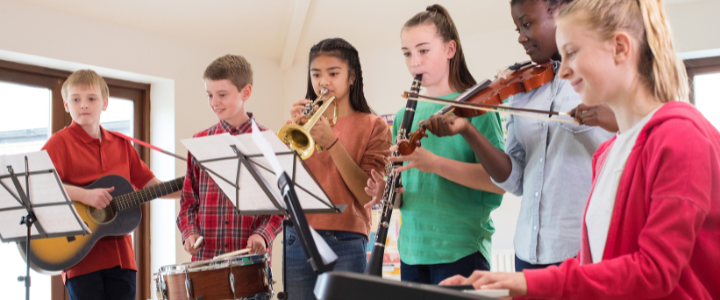.png?width=720&height=300&name=1.23%20Blog%20(1).png)
Music educators are uniquely positioned to orchestrate connections between student culture and the universal language of music. Quality professional learning is key to making this happen. In our new music-focused course, 5214: Teaching for Equity in the Music Classroom, you will explore strategies to expand students’ musical understanding beyond the Western classical perspective to honor a different approach: one that both affirms the music students are familiar with.
We share resources to assist PreK-12th grade music educators to create a more representative curriculum and design inclusive lessons that will inspire a lifelong love of music!
Take a look at this sneak peek from one of the applications you will find in this course designed for music educators!
Application: Making Program and Curricular Choices that are Culturally Responsive
Being culturally responsive means intentionally making curricular and programmatic choices using what you know about your students. In this application, you will be thinking about ways to acknowledge the ethnic and cultural diversity of your students. At Davis Elementary in Tucson, AZ, teachers engage in culturally responsive practices to ensure their students feel seen and valued. Take a look!
Next, explore the resources presented below to guide your work in bridging the gap between home and school culture.
- Pages 110-116 of the course text (Culturally Responsive Teaching in Music Education: Understanding to Application by Constance L. McKoy and Vicki R. Lind) illustrate examples and strategies for acknowledging diversity in the classroom
- The Decolonizing the Music Room – Research & Philosophy site offers links to other websites to take a deeper dive into more affirming curricula for students of color
- Czarina Jimenez’s article, “Music as a Tool to Build Empathy in an Anti-Racist Classroom,” demonstrates the power of empathy as students learn about the music of A Tribe Called Red, a First Nations music group.
Analyze the curriculum you use for a single grade level or ensemble, or across curricula using the questions below for guidance. No need to respond in writing.
- How representative of your current student population is the curriculum?
- In what ways could you incorporate students’ preferences, materials, and experiences?
- Which songs, if any, have questionable lyrics or historically racist undertones?
- Which concepts and skills could be taught with music representing a culture that is currently underrepresented in your curriculum?
- Which lessons could be modified to include more culturally responsive teaching practices?
Now it’s time to get to work planning for your swap! Find 5 or more songs, activities, or lessons you could add/modify in your curriculum. You may also wish to identify songs to replace outdated or offensive ones to ensure your student population is affirmed in their identities. Here are two additional resources that can also give you a place to start:
Once you’ve identified items to modify, complete the following chart listing songs, activities, or lessons you’ve identified to swap.
|
Current Song/Activity/Skill |
New Song/Activity |
Rationale |
|
Example: Shortnen’ Bread – American Folk Song |
Get Up Stand Up by Bob Marley |
5th Grade students are working on strumming one-chord songs on guitar. Shortnen’ Bread uses only one chord the original lyrics are inappropriate and derogatory. Get Up Stand Up also uses one chord (can be transposed to Em) and introduces students to Reggae music and a popular Jamaican composer/musician that students are familiar with. |
|
1. |
||
|
2. |
||
|
3. |
For more inclusive and innovative strategies to use in your music classroom, check out course 5214: Teaching for Equity in the Music Classroom.
